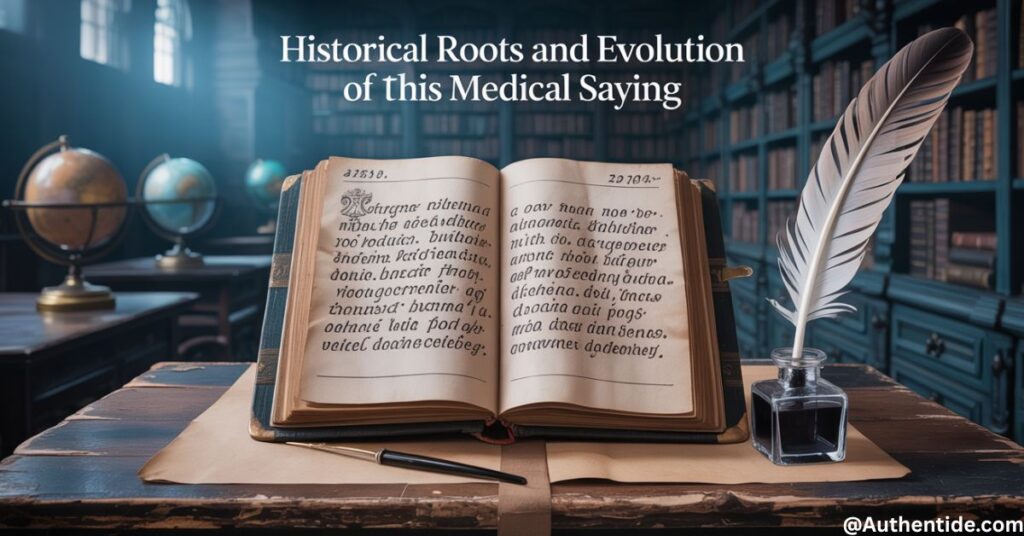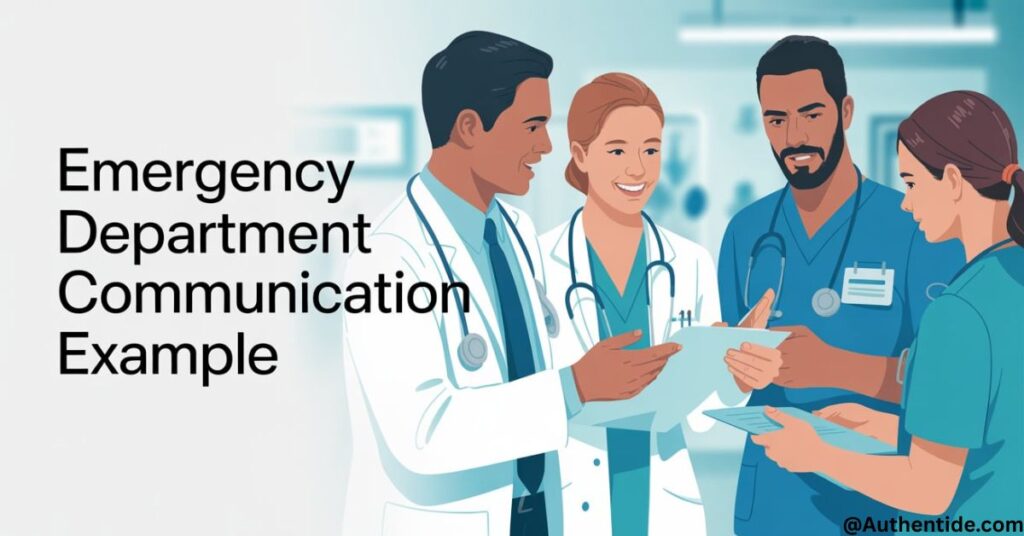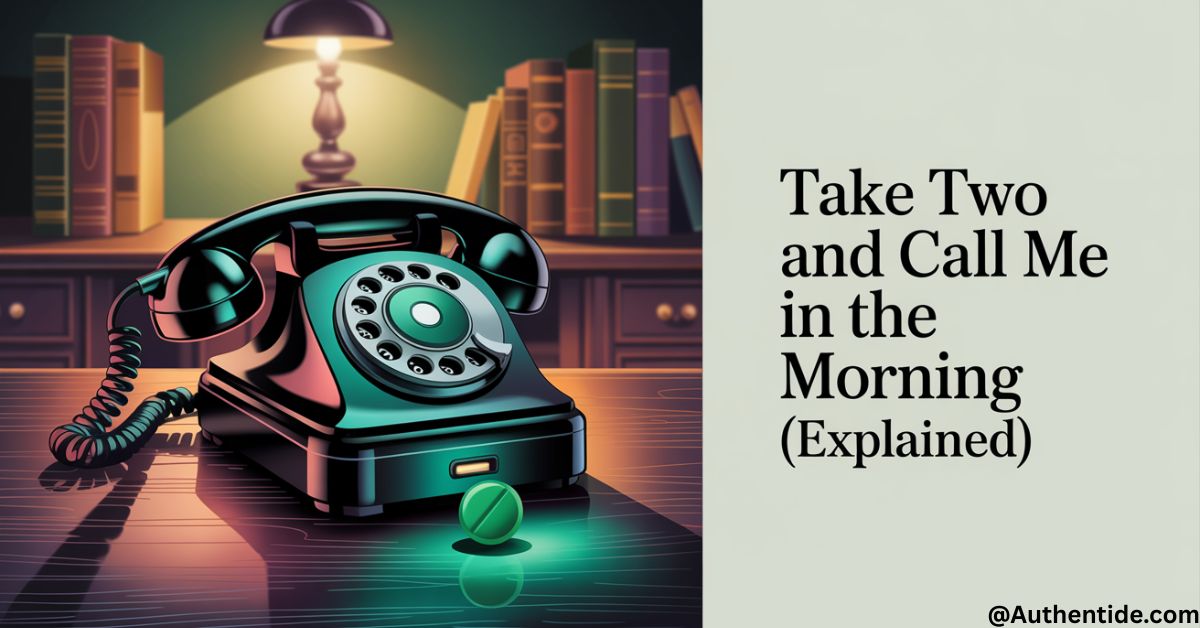Take Two and Call Me in the Morning might sound like advice your grandmother dispensed with a knowing smile, but this enduring phrase carries decades of medical wisdom wrapped in just eight simple words. Picture this: you’re slumped over your kitchen counter at 2 AM, nursing a splitting headache after a stressful day. Your doctor’s office won’t open for hours, yet somehow those familiar words echo in your mind. This isn’t just folksy wisdom it is a carefully crafted approach to healthcare communication that has shaped how millions navigate the delicate balance between self-care and professional help.
The beauty of this phrase lies in its elegant simplicity. When Dr. Sarah Mitchell tells her patient Jennifer, “Take two aspirin and call me in the morning,” she’s offering more than just an over-the-counter remedy. She’s providing a structured pathway that acknowledges both the patient’s immediate discomfort and the doctor’s professional responsibility. This approach transforms what could be anxiety-inducing uncertainty into manageable, step-by-step self-treatment guidance.
The True Significance Behind This Timeless Medical Expression
The meaning of take two and call me in the morning extends far beyond its surface-level instruction about medication. At its core, this phrase represents a revolutionary shift in how healthcare providers approach minor health problems. Instead of immediately escalating every concern to expensive office visits or emergency room trips, it introduces the concept of patient self-monitoring within professional boundaries.
Consider Mark, a 35-year-old accountant who emails his doctor: “Dr. Johnson, I’ve got this nagging headache that started after my presentation today. It’s not severe, but it’s persistent. Should I be worried?” A traditional response might involve scheduling an appointment or recommending immediate evaluation. However, Dr. Johnson’s reply demonstrates the practical application: “Mark, this sounds like tension-related discomfort. Take two ibuprofen and give me a ring tomorrow if you’re not feeling better. Monitor for any sudden changes like vision problems or severe pain.”
This approach accomplishes several crucial objectives simultaneously. First, it provides immediate relief strategy for the patient’s current discomfort. Second, it establishes clear parameters for when to see a doctor if symptoms persist or worsen. Third, it maintains the doctor-patient relationship history by keeping communication channels open without creating unnecessary urgency.
The phrase also serves as a gentle reminder about symptom management versus symptom elimination. It acknowledges that not every physical discomfort requires immediate medical intervention, yet maintains professional oversight. This balance has become increasingly important in our current healthcare landscape, where persistent or worsening symptoms can quickly overwhelm medical systems if not properly triaged.
Historical Roots and Evolution of This Medical Saying

The origin of take two and call me in the morning traces back to the early 20th century when aspirin for headache treatment became widely available. During this era, doctors made house calls and maintained closer relationships with their patients. Dr. William Hayes, a fictional but representative physician from the 1940s, might have told Mrs. Eleanor Thompson: “Eleanor, you’ve got the beginnings of what looks like a common cold treatment situation. Take two aspirin tonight, rest well, and telephone me tomorrow afternoon.”
This historical medical saying emerged from practical necessity. Before modern diagnostic equipment and 24-hour medical facilities, physicians relied heavily on patient observation and gradual symptom tracking. The phrase represented a sophisticated form of healthcare phrase meaning that encompassed multiple layers of medical practice: immediate intervention, patient responsibility, and professional follow-up.
What’s fascinating about this evolution is how it reflects changing attitudes toward self-care medical advice. In earlier decades, patients rarely questioned medical authority. However, as healthcare became more collaborative, phrases like “try a couple and give me a ring tomorrow” began empowering patients to participate actively in their own care while maintaining professional guidance.
The transformation of this phrase also mirrors broader changes in pharmaceutical accessibility. When over-the-counter medications became more widely available, the practical application expanded beyond just aspirin. Today, when Dr. Lisa Chen tells her patient Robert via email, “Take two pills and let me know how you’re feeling,” she might be referring to ibuprofen, acetaminophen, or other appropriate mild illness remedy options.
Practical Applications in Modern Healthcare Communication
Understanding how to properly implement this approach requires recognizing appropriate contexts and boundaries. The phrase works best for minor health problems that don’t present immediate danger but cause discomfort or concern. Let’s examine some realistic scenarios where this guidance proves most effective.
Email Communication Example:
Subject: Mild Stomach Discomfort After Dinner
“Hi Dr. Martinez,
I hope this message finds you well. I’m experiencing some mild stomach upset that started about two hours after dinner tonight. It’s not severe pain, just uncomfortable bloating and slight nausea. I haven’t vomited, and I don’t have a fever. Should I be concerned?
Thanks, Amanda Stevens”
Dr. Martinez’s Response:
“Amanda,
Based on your description, this sounds like mild digestive upset, possibly from something you ate. Take two antacids now and another dose in four hours if needed. Stick to bland foods tomorrow and plenty of water. Call me in the morning if you develop fever, severe pain, or vomiting. If symptoms worsen significantly tonight, don’t hesitate to seek immediate care.
Best regards, Dr. Martinez”
This exchange demonstrates several key principles. The doctor acknowledges the patient’s concern, provides specific self-treatment guidance, establishes clear parameters for reassessment, and includes safety warnings for escalation.
Text Message Scenario:
Patient (Kevin): “Doc, got this annoying cough that started yesterday. No fever, just dry and irritating. Thoughts?”
Dr. Williams: “Kevin, sounds like early respiratory irritation. Try cough drops and extra fluids. If it’s productive or you develop fever, give me a ring tomorrow. Otherwise, check in Friday if not improving.”
This abbreviated format maintains the essential elements while adapting to modern communication preferences.
Alternative Expressions and Modern Variations

The core concept of “take two and call me in the morning” has spawned numerous variations that convey similar messages while adapting to different situations and communication styles. Healthcare providers have developed creative ways to express this same philosophy using contemporary language.
Dr. Rachel Park often tells her patients: “Try this simple remedy for discomfort and touch base with me tomorrow.” This variation emphasizes the temporary nature of the intervention while maintaining the follow-up component. Similarly, Dr. James Liu might say: “Let’s start with basic symptom management and reassess in 24 hours.”
These modern variations serve the same fundamental purpose while addressing different patient personalities and situations. Some patients respond better to technical language, while others prefer conversational approaches. The key lies in maintaining the three essential components: immediate intervention, time-bound trial period, and professional follow-up.
Workplace Communication Example:
Internal Message to Company Nurse:
“Hi Nurse Thompson,
Several employees have mentioned feeling under the weather today—nothing serious, just general fatigue and mild headaches. It seems like stress from the quarterly deadline might be contributing. What’s your recommendation for helping them manage these symptoms?
Best, HR Director Patricia Kumar”
Nurse Thompson’s Response:
“Patricia,
This sounds like stress-related discomfort combined with possible seasonal factors. I’d recommend employees take appropriate over-the-counter pain relievers as directed on packaging, ensure adequate hydration, and practice stress-reduction techniques today. Have them contact me tomorrow if symptoms persist or worsen. I’ll also send out a wellness email with specific guidance from a medical professional about stress management during busy periods.
Thanks, Nurse Thompson”
Determining Appropriate Usage and Timing
Recognizing when this approach fits requires understanding the distinction between minor health problems that benefit from watchful waiting versus sudden severe symptoms that demand immediate attention. The decision-making process involves evaluating multiple factors simultaneously.
Appropriate scenarios typically involve:
- Mild headaches without neurological symptoms
- Minor digestive upset without severe pain
- Early cold symptoms without high fever
- Stress-related muscle tension
- Minor cuts or bruises without signs of infection
Inappropriate scenarios that require immediate evaluation include:
- Chest pain or difficulty breathing
- Sudden severe symptoms of any kind
- Signs of serious infection like high fever
- Neurological symptoms like confusion or severe dizziness
- Any condition causing significant distress or functional impairment
Professional Email Example:
From: Dr. Amanda Foster
To: Medical Resident Training Group
Subject: Guidelines for “Take Two and Call Me” Recommendations
“Team,
As we discussed in rounds, the “take two and call me in the morning” approach requires careful judgment. Here’s a framework for implementation:
Green Light Situations:
- Patient describes mild, familiar symptoms
- No red flag indicators present
- Patient demonstrates good health literacy
- Symptoms align with common cold treatment or minor pain management
- Patient has reliable follow-up communication methods
Red Light Situations:
- Any persistent or worsening symptoms that suggest serious pathology
- Patients with complex medical histories
- Symptoms that could indicate emergency conditions
- Patients who seem anxious about self-monitoring
Remember: when in doubt, err on the side of direct evaluation rather than remote guidance.
Dr. Foster”
Critical Warning Signs and Reassessment Triggers
The success of self-care medical advice depends heavily on patients understanding when to abandon the wait-and-see approach in favor of immediate professional evaluation. This knowledge protects both patient safety and maintains appropriate professional standards.
| Symptom Category | “Take Two and Call Me” Appropriate | Seek Immediate Care | Action Required |
|---|---|---|---|
| Headache | Mild tension headache, stress-related | Sudden severe headache, vision changes, confusion | Take two pain relievers, monitor closely |
| Fever | Low-grade fever under 100.4°F | Fever above 101°F, chills, severe fatigue | Over-the-counter remedy, increase fluids |
| Digestive Issues | Mild nausea, slight stomach upset | Severe pain, persistent vomiting, blood | Simple remedy for discomfort, bland diet |
| Respiratory | Minor cough, slight congestion | Difficulty breathing, chest pain, high fever | Common cold treatment approach, rest |
| Pain Level | Mild discomfort (1-4 on pain scale) | Severe pain (7+ on pain scale) | Mild illness remedy, reassess in 24 hours |
| Duration | Recent onset (under 24 hours) | Persistent or worsening symptoms over 48 hours | Patient self-monitoring with professional follow-up |
Immediate reassessment triggers that override the “take 2 and call me in the morning” approach include development of fever above 101°F (38.3°C), increasing severity of original symptoms, new symptoms that weren’t present initially, symptoms that interfere with sleep or basic functions, and patient anxiety about their condition.
Emergency Department Communication Example:

Scenario: Patient calls after following “take two and call me” advice
Patient (Monica): “Dr. Stevens, you told me yesterday to take two ibuprofen and call you today about my headache. The pain is actually worse now, and I’m feeling nauseous and dizzy.”
Dr. Stevens: “Monica, those are concerning changes from yesterday. The combination of worsening headache with nausea and dizziness needs immediate evaluation. I want you to go to the emergency department now rather than waiting. Consult a healthcare provider immediately when symptoms change like this.”
This example illustrates how the original advice included built-in safety mechanisms that triggered appropriate escalation when conditions changed.
The Psychology Behind Patient Empowerment
The enduring appeal of medical idioms and expressions like “take two and call me in the morning” stems from their ability to balance patient autonomy with professional oversight. This phrase empowers individuals to take active roles in their healthcare while maintaining safety nets.
Research in healthcare communication suggests that patients who receive structured self-care instructions demonstrate better health outcomes than those given either complete autonomy or rigid restrictions. The phrase creates what psychologists call “bounded autonomy”—freedom to act within professionally defined parameters.
Consider this patient testimonial from Sarah Henderson: “When Dr. Miller told me to ‘take two and give me a ring tomorrow’ about my back pain, I felt trusted to manage my own care. It wasn’t dismissive—it was collaborative. The next morning when I called to report improvement, I felt like an active participant in my recovery rather than a passive recipient of treatment.”
This psychological component explains why the phrase has survived decades of medical advancement. Even with sophisticated diagnostic tools and instant communication technology, the fundamental human need for balance between self-care and professional help remains unchanged.
Building Effective Doctor-Patient Communication
Implementing this approach successfully requires healthcare providers to establish clear communication protocols that protect patient safety while encouraging appropriate self-management. The most effective practitioners develop personalized variations that match their communication style and patient demographics.
Telemedicine Example:
Virtual Consultation Transcript:
Dr. Jessica Wong: “Tom, based on what you’ve described and what I can observe during our video call, your symptoms align with common seasonal allergies. Your eyes aren’t severely red, you’re not having breathing difficulties, and your energy level seems normal.”
Patient (Tom Rivera): “So what should I do? I’ve got this important presentation tomorrow.”
Dr. Wong: “Here’s my recommendation: take an over-the-counter antihistamine as directed on the package, use saline nasal rinse tonight, and avoid outdoor activities during high pollen hours today. Send me a message tomorrow afternoon about how you’re feeling. If you develop breathing problems, severe fatigue, or facial swelling, contact me immediately.”
Tom: “That sounds manageable. I appreciate having a clear plan.”
This interaction demonstrates how the traditional phrase adapts to modern healthcare delivery while maintaining its essential components.
Professional Implementation and Best Practices

Healthcare providers who successfully implement “take two and call me in the morning” approaches typically follow established protocols that ensure patient safety while maximizing the benefits of guided self-care. These protocols address communication methods, documentation requirements, and escalation procedures.
Documentation Example:
Patient Chart Entry by Dr. Michael Chen:
“Patient Jennifer Walsh, 28-year-old female, presented via secure messaging with complaint of mild headache and neck tension following stressful work deadline. No neurological symptoms, no fever, no visual changes. Symptoms began 4 hours ago. Advised over-the-counter pain relief (ibuprofen 400mg) and stress management techniques. Patient instructed to contact office tomorrow if symptoms persist or worsen. Emergency precautions discussed including signs requiring immediate evaluation: severe pain, visual changes, neurological symptoms, or significant worsening. Patient demonstrated understanding of instructions and emergency criteria.”
This documentation style protects both patient and provider while creating clear records of the care plan and safety instructions provided.
Modern Technology and Traditional Wisdom
The integration of historical medical sayings with contemporary healthcare technology creates new opportunities for effective patient care. Mobile apps, patient portals, and telemedicine platforms now facilitate the kind of structured follow-up that makes “take two and call me in the morning” approaches safer and more effective than ever.
Healthcare systems increasingly use automated follow-up messages that capture the spirit of this traditional approach. For example, after a virtual consultation for minor health problems, patients might receive this automated text: “This is a follow-up to your consultation with Dr. Adams about your cold symptoms. As discussed, continue the simple remedy for discomfort we recommended. If you’re not feeling better by tomorrow evening or if symptoms worsen, please use your patient portal to request urgent consultation.”
This technological enhancement maintains the personal touch while ensuring consistent follow-up communication that protects patient safety.
Conclusion
The phrase “take two and call me in the morning” represents far more than outdated medical advice—it embodies timeless principles of healthcare that remain remarkably relevant in our modern medical landscape. This approach successfully balances patient empowerment with professional oversight, creating frameworks for self-care medical advice that protect safety while encouraging autonomy.
Understanding the meaning of take two and call me in the morning helps patients navigate the complex world of modern healthcare more effectively. It provides tools for distinguishing between situations requiring immediate professional intervention and those appropriate for careful self-monitoring with professional guidance.
Frequently Asked Questions
What does “Take Two and Call Me in the Morning” really mean?
“Take Two and Call Me in the Morning” means following a structured approach to mild illness remedy that includes immediate self-treatment, a waiting period for assessment, and professional follow-up. It’s not just about taking medication it’s about creating a safe framework for managing minor health problems with professional oversight.
Why is this phrase associated with “two aspirin”?
The association with aspirin for headache treatment stems from the origin of take two and call me in the morning during the early-to-mid 20th century when aspirin became widely available as an over-the-counter remedy. The “two” typically referred to the standard dosage that provided effective relief without exceeding safety recommendations.
How should I use this phrase in everyday language?
Use this approach for common cold treatment, mild headaches, minor aches, or stress-related symptoms that don’t present immediate danger. Always include clear parameters for when to see a doctor and specific instructions about persistent or worsening symptoms that require immediate professional evaluation.
Are there alternative ways to convey the same message?
Modern variations include “try a couple and give me a ring tomorrow,” “take two pills and let me know,” or “try this simple remedy for discomfort and touch base tomorrow.” The key is maintaining the three essential components: immediate intervention, time-limited trial, and professional follow-up.
Under what circumstances should I reconsider and seek immediate medical attention?
Sudden severe symptoms, high fever, neurological changes, breathing difficulties, chest pain, or any condition causing significant distress requires immediate evaluation rather than the wait-and-see approach. When in doubt, consult a healthcare provider immediately rather than attempting self-management.
Why is the historical context of this sentence important?
Understanding the historical medical sayings context helps appreciate how doctor-patient relationship history has evolved toward more collaborative care. This phrase represents a bridge between paternalistic medicine and patient empowerment, showing how healthcare communication can balance professional expertise with patient autonomy effectively.

Your go-to place for smart synonyms and celebrity updates. Muhammad Hassan Abid is dedicated to creating useful, engaging content that informs, inspires, and truly serves your curiosity

